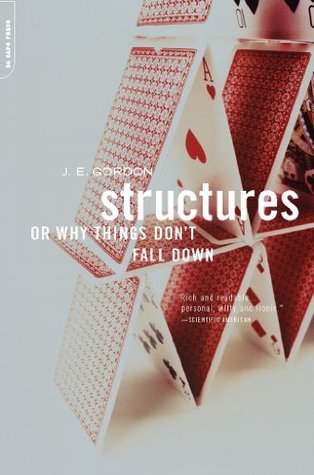More on this book
Community
Kindle Notes & Highlights
by
J.E. Gordon
Started reading
November 23, 2017
Wonders there are many, but there is no wonder Wilder than man – Man who makes the winds of winter bear him, Through the trough of waves that tower about him, Across grey wastes of sea; Man who wearies the Untiring, the Immortal– Earth, eldest of the Gods, as year by year, His plough teams come and go. The care-free bands of birds, Beasts of the wild, tribes of the sea. In netted toils he takes. The Subtle One. Sophocles, Antigone (440 B.C.; translated by F. L. Lucas)
Most engineers have had no aesthetic training at all, and the tendency in the schools of engineering is to despise such matters as frivolous.
but then this sort of theory is probably only rarely used by successful engineering designers. What is actually needed for a great many ordinary purposes can be understood quite easily by any intelligent person who will give his or her mind to the matter.
In fact he could usually go on loading and unloading structures of this kind indefinitely without causing any permanent change of shape. Such behaviour is called ‘elastic’ and is common.
However, a certain number of solids and near-solids, like putty and plasticine, do not recover completely but remain distorted when the load is taken off. This kind of behaviour is called ‘plastic’.
This paper contained the famous statement ‘ut tensio sic vis’ (‘as the extension, so the force’). This principle has been known for three hundred years as ‘Hooke’s law’
Leonhard Euler (1707–83) and Thomas Young (1773–1829),
realize that the stress in a material, like the pressure in a fluid, is a condition which exists at a point and it is not especially associated with any particular cross-sectional area, such as a square inch or a square centimetre or a square metre.
The strength of a material is the stress (in p.s.i. or MN/m2 or kgf/cm2) required to break a piece of the material itself.
We might now sum up what has been said in this chapter: load
It expresses how ./or the atoms at a point within a solid are being dragged apart or pushed together.
Strength. By the strength of a material we usually mean that stress which is needed to break it.
Naturally all this business about stresses and strains is only a means to an end; that is, to enable us to design safer and more effective structures and devices of one kind or another and to understand better how such things work.
Nature is generally a better engineer than man. For one thing she has more patience and, for another, her way of going about the design process is quite different.
Unfortunately, these design methods are not, as yet, available to human engineers, who are therefore driven to use either guesswork or calculation or, more often, some combination of the two.
Thomas Telford (1757-1834), whose magnificent bridges we can still admire, it is related that:
For a semi-circular notch or a round hole (when r — L) the stress will thus have the value of 3s; but for openings like doors and hatchways, which often have sharp corners, r will be small and L large, and so the stress at the corners may be very high -quite high enough to account for ships breaking in two.
Anything which is, so to speak, elastically out of step with the rest of the structure will cause a stress concentration and may therefore be dangerous.
S I unit of energy, which is the Joule, that is the work done when one Newton acts through one metre.*
Possibly for this reason the concept of energy came rather late into the scientific world, being introduced in its modern form by Thomas Young in 1807.
This quality of being able to store strain energy and deflect elastically under a load without breaking is called ‘resilience’, and it is a very valuable characteristic in a structure. Resilience may be defined as ‘the amount of strain energy which can be stored in a structure without causing permanent damage to it’.
In this respect most structures have to be a compromise between stiffness and strength and resilience, and the achievement of the best compromise is likely to tax the skill of a designer severely.


